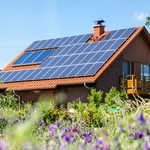Babcock Ranch: Is This Small Community Paving the Future of Solar Power in America?

Learn how cutting-edge sustainable architecture and solar technology helped one innovative Florida community weather a major storm.
Hurricane Ian devastated numerous Florida towns and homes. But unlike many areas on the western Florida shoreline, one community 30 miles inland, Babcock Ranch, suffered insignificant damage. While the storm displaced many families before and after, this community returned to “normal” fairly quickly.
Babcock Ranch claims to be the first solar-powered town of the future. Its homes and utilities were designed to withstand major storms, a significant factor in limiting the damage from Hurricane Ian. With so many environmentally-friendly features involved in solar energy, that’s no small feat.
So what makes this town so different? We dug in to learn more about its sustainable urban development.
On This Page
What is Babcock Ranch Doing Differently?
A few things set Babcock Ranch apart from other Florida towns.
First, every inch of the town was designed with sustainability in mind. Buildings were made of storm-resistant materials. Off-grid solar panels generate enough power for all its residents. And its wastewater system is such that if the town loses control or access to water, it won’t run out.
Benefits of Solar Power
Solar power is a great way to prepare for natural disasters, but it also helps you save money and be more sustainable. Some of the benefits of solar power include:
- Fewer worries about power outages. If your solar panels are installed correctly, they can still generate energy during an outage.
- The energy from your solar panels can charge batteries, so you won’t have to rely on electricity from the grid. This is especially useful if you live in an area prone to power outages or other natural disasters that could leave you without access to electricity for days at a time.
- The carbon footprint for solar panel use is roughly 20 times less than that of coal-powered electricity sources, depending on how much sunlight you get and how much energy the panels produce overall. Many people install solar power systems because they want lower monthly bills—and it works.
Could This Be the Future?
It’s not just Babcock Ranch moving towards solar power. Many other communities are making the switch because solar power benefits the environment. It can reduce greenhouse gas emissions from sources like coal-fired power plants by up to 80 percent.
Solar energy is also much more economical than you might think. According to the U.S. Energy Information Administration (EIA), electricity from rooftop solar panels costs about five cents per kilowatt hour in areas with average sunlight, less than what you’re likely to pay for electricity from a utility company.
With all these benefits, it begs the question: Will your community be next?



